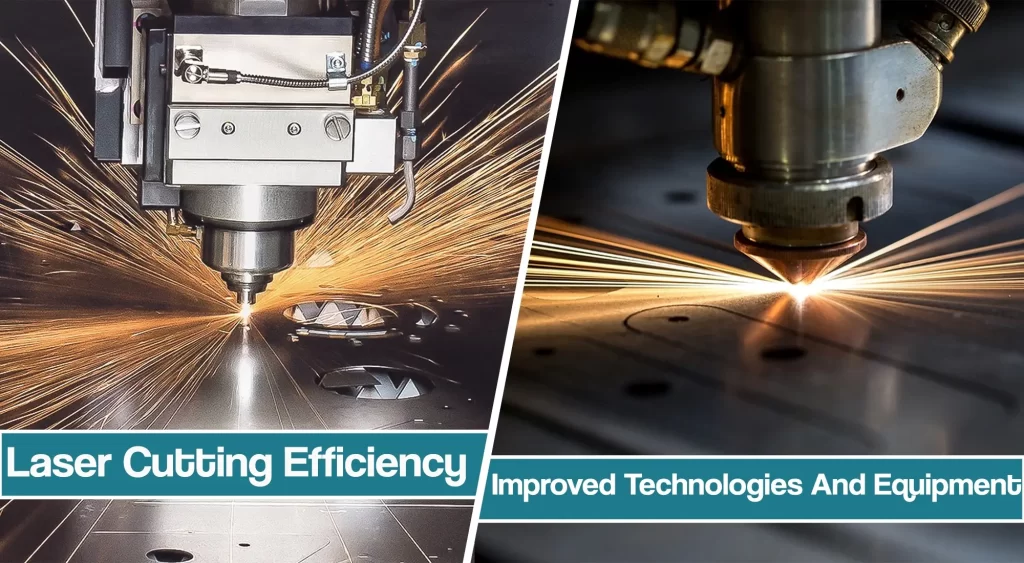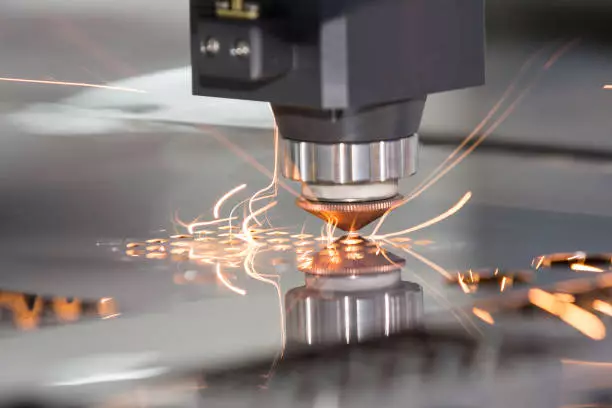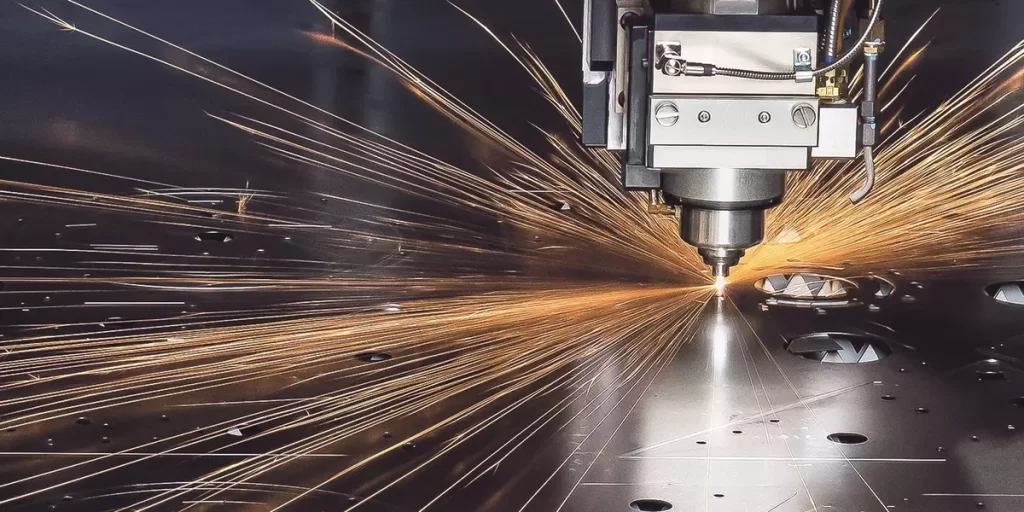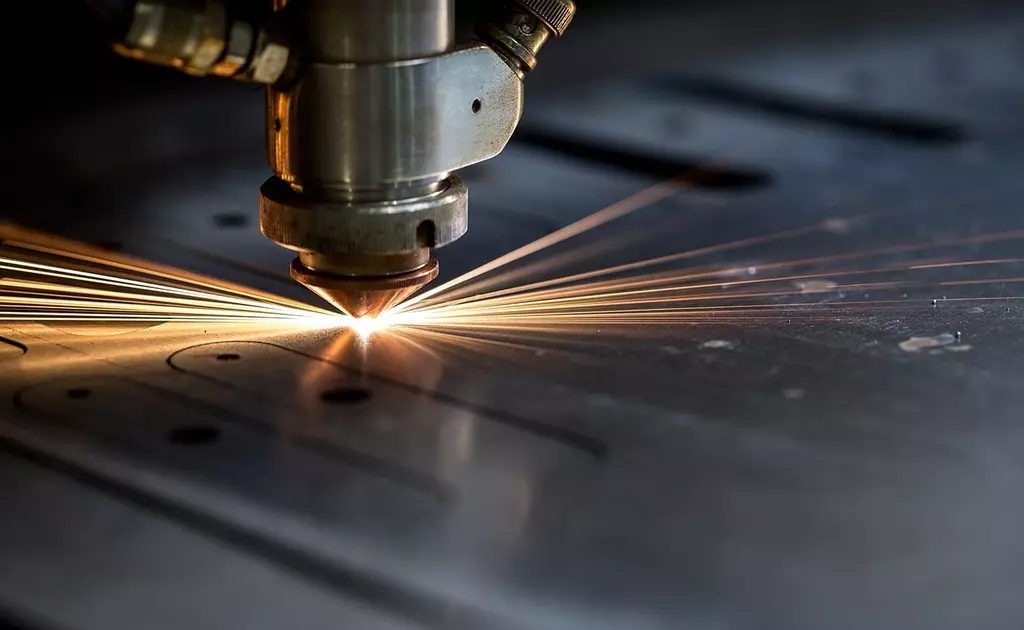Metal-working shops no longer consider industrial cutting lasers exotic and sophisticated machines but commonplace tools. Most medium-and high-volume production shops count laser cutting among their basic capabilities.
Laser machines have a high initial expense, but the trade-off is high throughput speeds and lower operating costs, with no blades to maintain or special coolant requirements.

In addition, the laser beam produces an edge with a high-quality surface finish. By substituting a light beam for a metal blade. The introduction of contaminants is eliminated, and fragile or flimsy parts can be produced — as an example, the greeting card industry uses lasers to create intricate, lacelike cut-outs in paper stock. That’s why we are considering improving laser cutting efficiency.
A laser beam can be moved in any direction with a high degree of precision and repeatability, and lasers can cut through abrasive, sticky or very hard materials. Moreover, little material is lost in the cutting process because the beam can be tuned down to several thousandths of an inch in width. There also is a reduced chance of heat warping surrounding areas during a cut, as laser systems have a small heat-affected zone.
Types of Laser Cutting Equipment
Most metal cutting laser systems use CO2 gas or solid-state Nd: YAG as a lasing medium. The laser output melts, burns, or vaporizes stock after passing from the beam generator through an optical system of mirrors and lenses.
Oxygen is often added to the laser beam at the point of contact on the material, typically at pressures of 100 psi, to assist the cutting process. The slag produced in the cutting is blown away by nitrogen gas fed at pressures as high as 400 psi through orifices around the laser head.

Lasers can be used to cut sheet, structural, and pipe materials. There are 5-axis and 6-axis laser systems that are designed for cutting operations on cast or machined parts. Like a milling machine, the laser enters a sheet of material through one side and cuts through the axis of the beam.
If a cut must start somewhere other than the material’s edge, the laser beam is often pulsed to create a starting hole. Pulsed lasers that provide a high power burst of energy for a short period are highly effective in some laser cutting processes, particularly for piercing, or when tiny holes or low cutting speeds are required. The heat produced could melt the entire piece if a constant laser beam were used in such applications.
There are generally three types of industrial laser cutting machines. Flying Optics lasers typically feature a stationary table on which a gantry moves the laser head in both X- and Y-axis over the workpiece. Flying Optics machines are popular because the stationary tables reduce the cost of the machine. Cutting speed limits are also higher because the movement of the lower mass optics can be accomplished more quickly than moving the mass of the table.
Hybrid and Pivot-Beam lasers use a table capable of X-axis travel. Because of this, the laser head has to move only in the shorter distances of the Y-and Z-axes, thus improving efficiency and speed.
Improving Laser Cutting Efficiency
Improved beam generators and optical paths have resulted in higher efficiencies that put greater power at the cutting head. Currently, most laser cutting systems can process materials to 1-in. thicknesses.
Processing speed is the most significant advantage with lasers, and advances in motion control system design, coupled with power increases, have led to increased cutting rates. One of the systems, the Syncrono 2-D cutting system manufactured by Prima North America can produce more than one thousand 0.080-in. dia. holes, spaced 0.125-in. apart, in a piece of 0.040 mild steel in one minute.

Prima designed a gantry on which two linear-driven, parallel kinematic axes control the laser head to attain that speed. These axes are separate from the gantry’s own motor drives. The use of small motors and titanium components makes the head capable of changing the beam’s direction at accelerations of up to 6G. The head’s small inertia and damped mounting cuts vibration effectively, especially for a machine in which the massive cutting head support gantry is secured at only one end to its X-axis drive.
Like many 2-D machines, Synchrony has an option for a rotary axis component with an automated collar that grips and rotates pipe and tubing stock in coordination with the laser head movement. The 4000W CO2 laser unit used in the Syncrono is common to several other Prima machines, and resides immediately behind the machine’s table and gantry system.
Robotics in Laser Cutting
Laser cutting tools fitted to industrial robots perform 3-D cutting by reaching in and around tooling to cut required features into a part.
Bowever, such a system is best suited to applications such as draw stampings, which have complex shapes that require the cutting head to achieve many different attitudes to cut specified features.

Another promising application is cutting hydroformed tube sections used in automotive frames, in which holes are challenging to punch because they have closed sections that limit access to the back of the material. For most robotic laser cutting applications, aluminum and steel parts should be only 0.02-in. to 0.2-in. (0.5 mm to 5 mm) thick.
A typical robotic laser cutting system couples a servo-controlled, multiaxis mechanical arm with a laser cutting head mounted to the faceplate of the robot arm. The cutting head has focusing optics for the laser light and an integral height control mechanism. An assist gas delivery package distributes cutting gases, such as oxygen or nitrogen, to the cutting head.
Most systems use an Nd:YAG laser generator that delivers the laser beam to the robot cutting head through a fiber-optic cable, while others that use a CO2 laser generator employ a mechanical flexible arrangement with mirrors at each joint. A robot’s smaller footprint, compared to most table-based laser cutters, permits a higher density of laser cutting workcells in a given area, provided enough access space exists for the cutting head.
Power In A Small Package
The fiber laser is one major advancement replacing CO2 and Nd: YAG lasers in industrial applications, from microelectronics to cutting ship plate.
One market research firm, quoted in a recent issue of the Wall Street Journal, has suggested that most industrial lasing systems will use fiber lasers.
These lasers begin with a laser diode — a far more powerful cousin to the lasers used in CD players — providing light energy.

The light is transmitted via an optical fiber to the target, rather than conventional optics, passing within the fiber bundle to smaller fibers that amplify the light energy. The fibers are doped with a rare earth material such as ytterbium or erbium that further amplify the energy output.
According to Bill Shiner, director of Industrial Market Development at fiber laser manufacturer IPG Photonics Corp. fiber laser systems have a higher efficiency than conventional lasers. They cost less to operate and require less maintenance because there are no optics to align or to become contaminated and no consumables that would need to be replaced.
The diodes used by IPG Photonics have estimated lives of more than 100,000 hours, and thermal management allows for a reduction in the size of the beam generator package. The special optical fiber, while strong, is flexible enough for attachment to a robot arm. Additionally, diode and optical fibers can be combined to produce a higher output power, or different powers combined for different tasks, such as cutting and welding in a single robot,
Many optical lasers are being retrofitted with fiber laser systems. Marshall Smith, a controls engineer for Dana Corp., describes a work cell with a diode-pumped 1600W Nd: YAG laser, whose output was passed along a multiaxis robot arm through a 300 micron fiber for cutting 3.2 mm mild steel.
The problem, says Smith, was that the unit, which had an additional 7 mirrors plus an optical modulator, required frequent and costly maintenance. Last September, the system was changed to a 1,000W IPG unit, with output passing through a 100-micron fiber bundle. Smith says the cycle time per component did not change but, more importantly, the unit has not needed any adjustments since it was installed.





